|
While panning around the moon with my color Vesta Cam, it became very obvious that certain areas on the moon were strongly colored, in tints that ranged from pale sea foam green to reds and browns. One of the most strongly colored regions I found during this sweep of the nearly full moon was the region around Aristarchus seen above. Color accuracy was checked by ensuring that the jumbled highlands material at the top, near the Jura Mountains which is composed of broken crystalline rock was neutral in color as most of the Highland material is. The Lunar seas above Aristarchus are tinted in shades of blues, on the right edge, greens and more toward purplish at the bottom. Browns and yellows mark the Aristarchus Hills area which contain the Schroters Valley complex. The Rumker Plateau region to the top left is also decidedly ruddy. And an arcing plume of reddish material can be seen to the right of Aristarchus. Instrument: 12.5" f/5 Home made Newtonian Platform: Astrophysics 1200 QMD CCD Camera: Vesta Cam Pro Exposure: 1/500 Filters: None Location: Payson, Arizona Elevation: 5150 ft. Sky: Seeing FWHM = Average, Transparency 8/10 Outside Temperature: 5 C Processing Tools: Photoshop, Registax
|
||
|
FastCounter by bCentral |
